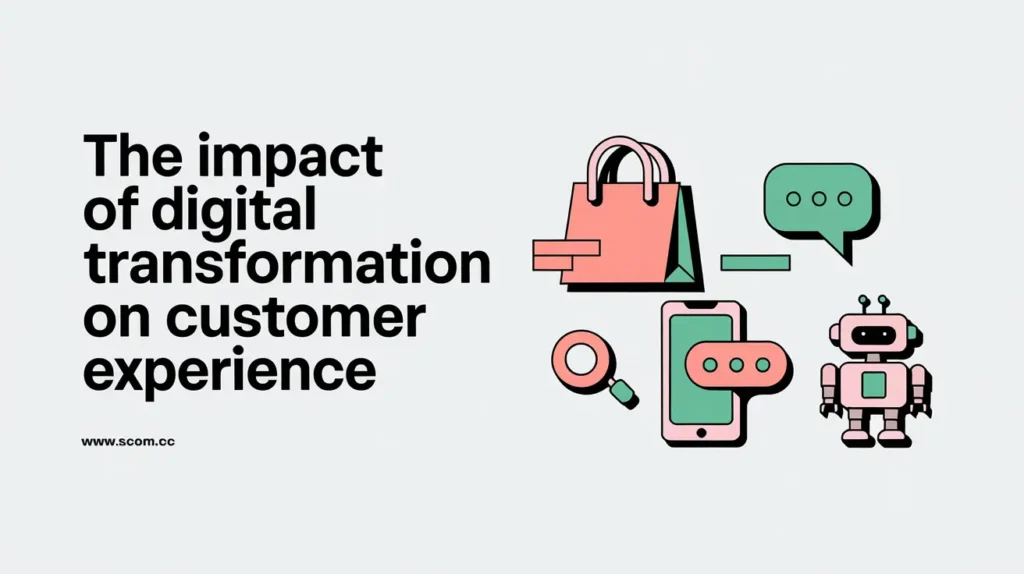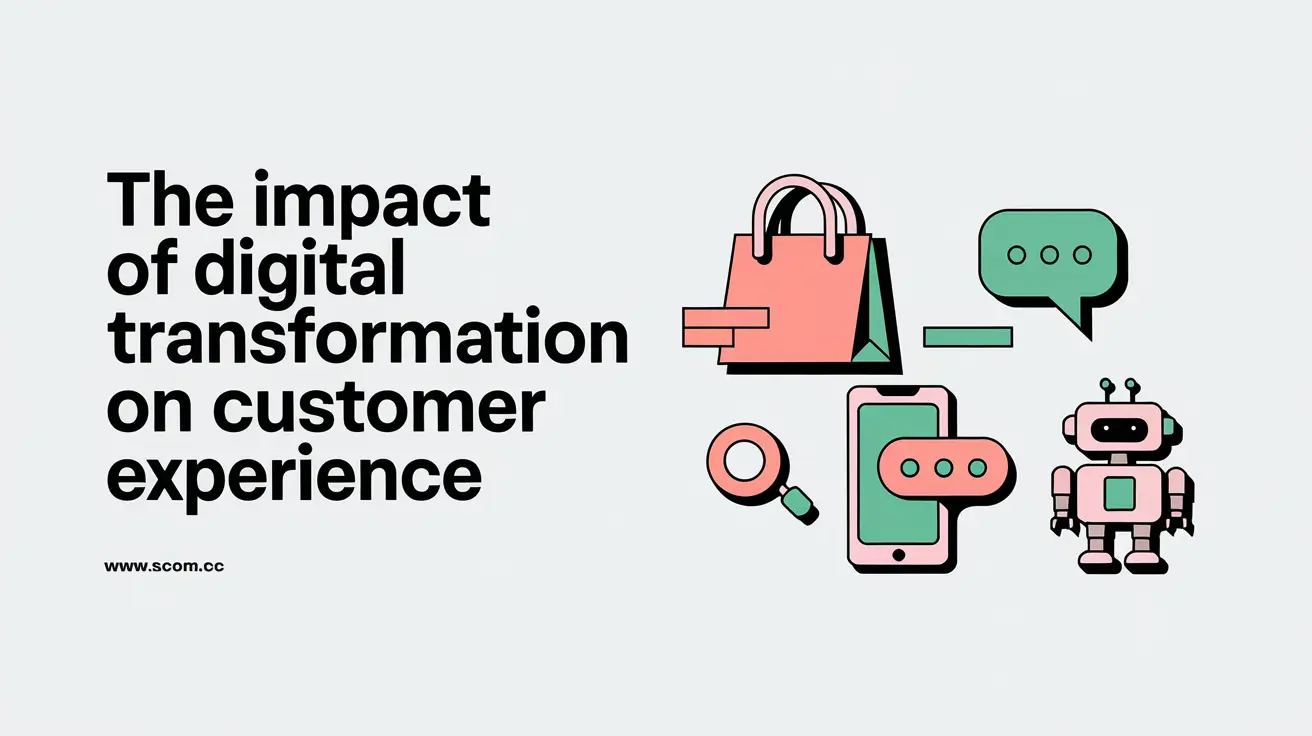The Impact of Digital Transformation on Customer Experience

- The Impact of Digital Transformation on Customer Experience
- Understanding Digital Transformation and Customer Experience
- Personalization and Customization
- Enhancing Customer Engagement
- Improving Customer Service and Support
- Streamlining Customer Journeys
- Leveraging Data for Insights
- Enhancing Security and Privacy
- Measuring the Impact of Digital Transformation
- Future Trends in Digital Transformation and Customer Experience
-
FAQ
- How does digital transformation impact customer experience?
- What are some examples of personalization through digital transformation?
- How can businesses enhance customer engagement through digital transformation?
- What role does data analytics play in improving customer experience?
- How can businesses ensure data security and privacy during digital transformation?
- What are some key performance indicators (KPIs) for measuring the impact of digital transformation?
- What are some future trends in digital transformation affecting customer experience?
The Impact of Digital Transformation on Customer Experience
Understanding Digital Transformation and Customer Experience
Digital transformation involves integrating digital technologies into various aspects of a business to improve operations and value delivery. It is not just about adopting new technologies but also about changing how businesses interact with customers and deliver their services.
What is Digital Transformation?
Digital transformation refers to the process of utilizing digital technologies to transform business processes, models, and strategies. This transformation aims to enhance efficiency, innovation, and customer engagement through the use of technology.
What is Customer Experience (CX)?
Customer experience encompasses every interaction a customer has with a company, from initial contact to post-purchase support. It includes the overall perception and satisfaction of the customer based on these interactions.
The Relationship Between Digital Transformation and CX
Digital transformation impacts customer experience by enabling businesses to interact with customers in more meaningful, efficient, and personalized ways. It can lead to improved customer satisfaction, loyalty, and advocacy.
Examples of Digital Transformation Enhancing CX
- Retail: Implementing AI-powered chatbots to provide instant customer support and personalized shopping experiences.
- Banking: Offering mobile banking apps that allow customers to manage their accounts, make transactions, and receive personalized financial advice.
- Healthcare: Utilizing telemedicine to provide remote consultations and patient management, improving access and convenience.
Personalization and Customization
One of the most significant impacts of digital transformation on customer experience is the ability to offer personalized and customized interactions.
Personalization Through Data Analytics
- Customer Data Collection: Businesses collect data from various sources, such as website interactions, purchase history, and social media activity.
- Data Analysis: Advanced analytics tools analyze this data to identify patterns and preferences.
- Tailored Recommendations: Based on the analysis, businesses can provide personalized recommendations and offers that align with individual customer preferences.
Customization of Products and Services
- Product Configurators: Allow customers to customize products according to their preferences (e.g., custom-built computers or personalized merchandise).
- Flexible Service Options: Offer customized service packages or flexible subscription plans based on customer needs.
Examples of Personalization
- E-commerce Platforms: Use browsing history and purchase data to recommend products tailored to individual preferences.
- Streaming Services: Provide personalized content recommendations based on viewing history and user ratings.
Enhancing Customer Engagement
Digital transformation enables businesses to enhance customer engagement through various channels and technologies, creating more interactive and meaningful experiences.
Omnichannel Engagement
- Unified Experience: Provide a seamless and consistent experience across multiple channels, including online, mobile, and in-store.
- Integrated Communication: Allow customers to switch between channels without losing context, such as starting a conversation on social media and continuing it via email.
Interactive Technologies
- Chatbots and Virtual Assistants: Offer real-time assistance and engage customers in interactive conversations.
- Augmented Reality (AR): Allow customers to virtually try products or explore services in an immersive environment.
Examples of Enhanced Engagement
- Travel Industry: Use mobile apps to offer real-time flight updates, booking management, and personalized travel recommendations.
- Retail: Implement AR features in apps to let customers virtually try on clothes or see how furniture would look in their homes.
Improving Customer Service and Support
Digital transformation significantly improves customer service and support by making it more efficient, accessible, and responsive.
Automated Customer Support
- AI-Powered Chatbots: Provide instant responses to common customer queries, reducing wait times and improving service efficiency.
- Automated Ticketing Systems: Streamline support requests and route them to appropriate support teams based on issue type and priority.
Self-Service Options
- Knowledge Bases: Offer comprehensive self-service resources, such as FAQs and tutorials, to help customers find solutions independently.
- Interactive Voice Response (IVR): Enable customers to navigate support systems and access information through automated phone menus.
Examples of Improved Support
- Telecommunications: Use chatbots to handle routine customer service inquiries and provide instant solutions to common problems.
- Software Companies: Offer detailed online knowledge bases and community forums where users can find answers and troubleshoot issues.
Streamlining Customer Journeys
Digital transformation helps streamline customer journeys by optimizing and automating various touchpoints in the customer lifecycle.
Journey Mapping
- Customer Journey Mapping: Visualize and analyze the entire customer journey, identifying key touchpoints and areas for improvement.
- Touchpoint Optimization: Implement changes to improve the efficiency and effectiveness of critical touchpoints, such as checkout processes or customer onboarding.
Automation of Processes
- Automated Marketing: Use marketing automation tools to deliver personalized messages and offers at different stages of the customer journey.
- Streamlined Operations: Automate backend processes, such as order fulfillment and inventory management, to enhance the overall customer experience.
Examples of Streamlined Journeys
- E-commerce: Implement one-click checkout and automated order tracking to simplify the purchasing process and keep customers informed.
- Healthcare: Use online appointment scheduling and automated reminders to streamline the patient journey from booking to consultation.
Leveraging Data for Insights
Data analytics plays a crucial role in digital transformation by providing insights that drive strategic decisions and enhance customer experience.
Data Collection and Analysis
- Customer Behavior Tracking: Collect data on customer interactions, preferences, and feedback.
- Predictive Analytics: Use predictive models to anticipate customer needs and trends based on historical data.
Data-Driven Decision Making
- Personalization Strategies: Apply insights from data analysis to tailor marketing strategies, product offerings, and customer interactions.
- Performance Monitoring: Track the effectiveness of digital transformation initiatives and make adjustments based on data-driven insights.
Examples of Data Utilization
- Retail: Analyze purchase data to optimize inventory levels and personalize promotional offers.
- Finance: Use customer data to detect fraud patterns and provide personalized financial advice.
Enhancing Security and Privacy
As digital transformation involves increased data collection and interaction through digital channels, ensuring robust security and privacy measures is essential.
Security Measures
- Data Encryption: Protect customer data through encryption during transmission and storage.
- Access Controls: Implement access controls to restrict data access based on user roles and permissions.
Privacy Compliance
- Regulatory Compliance: Adhere to data protection regulations, such as GDPR or CCPA, to ensure compliance and build trust with customers.
- Transparent Policies: Communicate privacy policies clearly and provide customers with control over their data.
Examples of Security and Privacy
- Financial Institutions: Implement multi-factor authentication and secure encryption protocols to protect sensitive financial information.
- E-commerce Sites: Use secure payment gateways and provide customers with options to manage their privacy settings.
Measuring the Impact of Digital Transformation
Evaluating the impact of digital transformation on customer experience involves tracking key metrics and assessing overall performance.
Key Performance Indicators (KPIs)
- Customer Satisfaction (CSAT): Measure overall satisfaction with products and services through surveys and feedback.
- Net Promoter Score (NPS): Assess customer loyalty and likelihood to recommend the business to others.
- Customer Effort Score (CES): Evaluate the ease of interacting with the company and resolving issues.
Feedback and Improvement
- Customer Feedback: Collect and analyze feedback to identify areas for improvement and refine digital transformation strategies.
- Continuous Improvement: Implement changes based on performance metrics and feedback to enhance customer experience continually.
Examples of Measurement
- Retailers: Track metrics such as customer satisfaction scores and online reviews to assess the impact of digital transformation on shopping experiences.
- Service Providers: Use NPS and CES to measure customer loyalty and ease of service interactions.
Future Trends in Digital Transformation and Customer Experience
The landscape of digital transformation and customer experience continues to evolve with emerging technologies and changing consumer expectations.
Emerging Technologies
- Artificial Intelligence (AI): Advancements in AI will further enhance personalization, predictive analytics, and automated customer interactions.
- Blockchain: Potential uses of blockchain for secure transactions and transparent data management.
Changing Consumer Expectations
- Increased Demand for Personalization: Customers will expect even more tailored experiences and interactions.
- Greater Emphasis on Privacy: Heightened awareness of data privacy will drive businesses to adopt stronger security measures.
Examples of Future Trends
- Virtual Reality (VR): Use VR for immersive shopping experiences and virtual product demonstrations.
- 5G Technology: Leverage 5G for faster, more reliable connectivity and enhanced digital interactions.
Summary Table
| Topic | Key Points |
|---|---|
| Understanding Digital Transformation and Customer Experience | Definition of digital transformation and customer experience, and their relationship. |
| Personalization and Customization | How digital transformation enables personalized interactions and customized products and services. |
| Enhancing Customer Engagement | Omnichannel engagement and interactive technologies that improve customer interactions. |
| Improving Customer Service and Support | Automated support and self-service options that enhance customer service. |
| Streamlining Customer Journeys | Journey mapping and process automation to optimize customer experiences. |
| Leveraging Data for Insights | Using data analytics to drive decisions and enhance customer experience. |
| Enhancing Security and Privacy | Security measures and privacy compliance to protect customer data. |
| Measuring the Impact of Digital Transformation | KPIs and methods for evaluating the impact of digital transformation on customer experience. |
| Future Trends | Emerging technologies and evolving consumer expectations influencing future digital transformation. |
FAQ
How does digital transformation impact customer experience?
Digital transformation enhances customer experience by enabling personalized interactions, improving engagement, streamlining service processes, and leveraging data for better insights.
What are some examples of personalization through digital transformation?
Examples include personalized product recommendations on e-commerce platforms and tailored content suggestions on streaming services.
How can businesses enhance customer engagement through digital transformation?
Businesses can enhance engagement through omnichannel strategies, interactive technologies like chatbots and AR, and real-time communication.
What role does data analytics play in improving customer experience?
Data analytics helps businesses understand customer preferences, anticipate needs, and make data-driven decisions to personalize and optimize interactions.
How can businesses ensure data security and privacy during digital transformation?
Implement data encryption, access controls, and comply with privacy regulations to protect customer data and build trust.
What are some key performance indicators (KPIs) for measuring the impact of digital transformation?
Key KPIs include customer satisfaction (CSAT), net promoter score (NPS), and customer effort score (CES).
What are some future trends in digital transformation affecting customer experience?
Emerging technologies like AI, blockchain, and 5G, along with changing consumer expectations for greater personalization and privacy, will shape the future of digital transformation.

If you enjoyed this article and found it valuable, we encourage you to explore our news and valuable information section, where you'll find more relevant and up-to-date content that may pique your interest. Additionally, if you are seeking advice or need guidance on a specific topic, we suggest visiting our services section. There, you will find a variety of options designed to assist and support you in addressing your needs. Feel free to check out both sections to get the information and assistance that best suits your requirements.

Leave a Reply